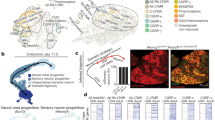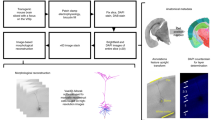Abstract
During development, neurones find and interconnect with their targets in a remarkably precise way. The unfolding of neuronal specificity involves a series of highly specific recognition events which are likely to be coordinated by the spatial and temporal expression of many different surface molecules. At early stages of development, neuronal recognition occurs most dramatically at the tips of growing axons, at growth cones and their filopodia1,2. Previous studies on the grasshopper embryo suggest that specific filopodial contacts lead to the stereotyped patterns of selective axonal fasciculation; these results support the ‘labelled pathways’ hypothesis which predicts that the different neighbouring axon fascicles in the embryonic neuropil within filopodial grasp are differentially labelled3–8. To uncover the molecular labels on fasciculating embryonic axons, we screened 2,000 monoclonal antibodies generated against the embryonic neuroepithelium9. Here we describe three antibodies which reveal surface antigens whose temporal and spatial expression during embryogenesis correlate with the predictions of the model. In particular, the Mes-2 antibody recognizes an antigen which is transiently expressed on the surface of only 4 out of ∼ 1,000 neurones in each metathoracic hemisegment during a short period of embryogenesis. The growth cones of two of these neurones fasciculate in the periphery and innervate the same target. Moreover, they transiently express the Mes-2 surface antigen while doing so.
This is a preview of subscription content, access via your institution
Access options
Subscribe to this journal
Receive 51 print issues and online access
$199.00 per year
only $3.90 per issue
Buy this article
- Purchase on Springer Link
- Instant access to full article PDF
Prices may be subject to local taxes which are calculated during checkout
Similar content being viewed by others
References
Bray, D. in Cell Behavior (eds Bellairs, R., Curtis, A. & Dunn, G.) 299–318 (Cambridge University Press, 1982).
Letourneau, P. C. in Neuronal Development (ed Spitzer, N. C.) 213–259 (Plenum, 1982).
Goodman, C. S., Raper, J. A., Ho, R. & Chang, S. Symp. Soc. Dev. Biol. 40, 275–316 (1982).
Raper, J. A., Bastiani, M. J. & Goodman, C. S. J. Neurosci. 3, 20–30 (1983a).
Raper, J. A., Bastiani, M. J. & Goodman, C. S. J. Neurosci. 3, 31–41 (1983b).
Raper, J. A., Bastiani, M. J. & Goodman, C. S. Cold Spring Harb. Symp. quant. Biol. 48, 587–598 (1983).
Bastiani, M. J., Raper, J. A. & Goodman, C. S. J. Neurosci. (in the press).
Raper, J. A., Bastiani, M. J. & Goodman, C. S. J. Neurosci. (in the press).
Kotrla, K. J. & Goodman, C. S. Soc. Neurosci. 9, 1045 (1983).
Ho, R. K., Ball, E. E. & Goodman, C. S. Nature 301, 66–69 (1983).
Ho, R. K. & Goodman, C. S. Nature 297, 404–406 (1982).
Taghert, P. H., Bastiani, M. J., Ho, R. K. & Goodman, C. S. Devl Biol. 94, 391–399 (1982).
Author information
Authors and Affiliations
Rights and permissions
About this article
Cite this article
Kotrla, K., Goodman, C. Transient expression of a surface antigen on a small subset of neurones during embryonic development. Nature 311, 151–153 (1984). https://doi.org/10.1038/311151a0
Received:
Accepted:
Issue Date:
DOI: https://doi.org/10.1038/311151a0
This article is cited by
-
From bristle to brain: embryonic development of topographic projections from basiconic sensilla in the antennal nervous system of the locust Schistocerca gregaria
Development Genes and Evolution (2024)
-
Ontogeny of pioneer neurons in the antennal nervous system of the grasshopper Schistocerca gregaria
Development Genes and Evolution (2017)
-
Axogenesis in the antennal nervous system of the grasshopper Schistocerca gregaria revisited: the base pioneers
Development Genes and Evolution (2015)
Comments
By submitting a comment you agree to abide by our Terms and Community Guidelines. If you find something abusive or that does not comply with our terms or guidelines please flag it as inappropriate.



